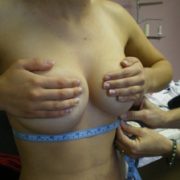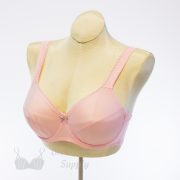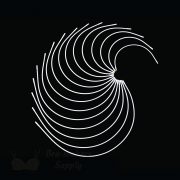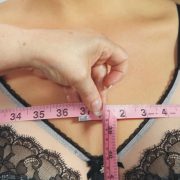The BCD Method of Measuring Explained
When I first started designing bra patterns, I was faced with a dilemma – what sizing system should I use? Some patterns want you to take the full bust measurement, the high bust measurement and subtract the two to find your cup size. Still others want the rib cage measurement plus a “magic number” they pull out of the sky (could be 3, 4 or 5) to determine your band size. There are actually FOUR ways of measuring for a bra and I talk about them here. But for my patterns, I asked myself if I should use the actual rib cage measurement or should I add the magic number? Should I use a DD size or not? So many of you, especially those in other countries, are baffled by the way we measure for bra patterns, and are shocked when the bra pattern size isn’t the same as their ready-to-wear bra size. Everyone at one time or another gets frustrated with bra pattern sizing. It was a real dilemma for me.

So… I developed my own method of bra sizing, called the Bottom Cup Depth, or BCD method. I used the method to create my patterns, because it was a method that worked. Unfortunately back then, I still named my patterns according to the ready-to-wear sizes most people in North America are familiar with. That decision to name it as RTW (ready-to-wear) sizing and not the BCD size was a decision I have regretted for almost twenty years. I confess, I wimped out. I thought no one would understand this whole new method of measuring, and therefore, no one would buy my patterns. I am determined to correct that error in judgement now. So here is the BCD method of measuring explained.
So what is the BCD measurement?
The BCD method measures the distance from the apex of the breast down to the wire line directly below it. That measurement in inches will determine your cup and frame size. Then take your Rib Cage measurement directly under your bra. That actual rib cage measurement (no magic number involved) is used for the band length. The combination of BCD and Rib Cage is your pattern size. For example, the BCD might be 4.0 and the Rib Cage of 32. In my BCD system, you would be a 4.0/32.
The BCD size increases by 1/4″ (6 mm) per size so if you happen to make a bra cup that is too small, you simply go up to the next BCD size. So if you made a 4.0 BCD, and it was too small, you can make the 4.25 size. Isn’t that crazy easy? No more figuring out sister sizing, or moving up one band size and down one cup size or relying on ready-to-wear sizing. It is so logical, it astonishes people and they ask why this hasn’t “always” been the way bra patterns are designed.
If you already have a bra pattern that fits, you can determine the BCD from that pattern. That will make it easy to find the BCD, assuming the seam across the bra runs across the bust point. Simply measure from the seam line (not the cutting line) at the apex, straight down to the seam line below it. For most patterns, it is the deepest area of the lower cup.

You must take the BCD measurement using a bra that fits. In a perfect world, the bottom cup depth on your bra should measure the same as the bottom cup depth on your naked breast, but it often doesn’t – because of the breast density and degree of flaccidity.The nipple will drift downward as the breast loses its self-supporting ability, which means that even if your bra size does not change over the years, your BCD will still decrease as you age. Nothing stops gravity. So it is imperative to wear a bra that fits (not a foam lined bra, or a sports bra either). The bra correctly sized, will actually appear to place the nipple in the ideal location.
Here is a chart that shows what BCD sizes correspond with “most” ready-to-wear sizes in North America and also my Pin-up Girls pattern sizes.

So why am I telling you this? Quite simply – all patterns I create from here on in, will be named as the BCD size and not typical bra sizes. The new Ruby and the Ingrid which will be released soon, are sized this way. Plus I will go back and re-vamp the other bra patterns to use this method. The custom bra-makers I have taught over the years, were trained on the BCD method and now you know about it too. It’s an idea whose time has come.












I like the bcd concept, I am sure it works for “sister sizing consept”. But I do not see how it works regarding volume. For example: 4.0/30 will have way less volume than 4.0/46. How do you include boob widths, both small and big (distance between wire sides or root of the boob, and same distance, but over the apex. So, basically ratio that calcilates half sphere volume for those measurements?
“You must take the BCD measurement using a bra that fits” Well, that’s a Catch-22: I can’t measure and make a bra that fits if I don’t have a bra that fits. Would you suggest measuring on bare skin?
Sydney, definitely you can measure bare skin. Lean over so everything is hanging loose and perpendicular to the floor. You can measure your BCD this way, as well as many other important measurements. Make sure you measure both breasts as they could be different!
Sorry Sidney, my phone autocorrected your name!
Thank you so much Beverley for doing what you do. I think women the world over should learn to make their own bras. I’ve taken your courses on Craftsy and refer to them often. I purchased your pattern for the classic bra before the bcd measurements were used and I also have another Pin up girls pattern (name escapes me). It’s helped me to make bras that fit and I haven’t gone shopping for ready to wear bras for a year now. Is there still and Australian stockist at all? I know Sew Squirrel turned not Underwired and then Covid hit and I can’t find her! You Craftsy classes have given me the courage to try other pattern companies and I’ve gone crazy making the Black Beauty bra by Emerald Erin. However, I’m particularly interested in your strapless bustier. With lots of off should fashions these days, it would be handy to have this one in the “collection”. I’m yet to get my head fully around the bcd method. It looks simple, I just have to put it into practise. I just couldn’t get the add 4″ thing! So antiquated. So thank you for clearing this up and explaining how it all works. We’re all better off.
I stay in South Africa. It will take years plus lots of tax to get a pattern here. Can I buy a pattern pdf using the BCD measurements?
We are not doing .pdf versions of the patterns right now. However we have a distributor in England who ships to South Africa. Her name is Mandy from Fit2Sew
Celia, Bra Makers South Africa stock the pin up girl patterns. Search for them on Facebook. You won’t regret it!
You can contact Ronel Stronkhorst https://www.facebook.com/groups/435209673305610 She is in Pretoria.
Pug Patterns can be ordered via Bramakers South Africa. There is.a FB page and a website. The owner is Ronel Stronkhorst.
Hi, I want to.purchase one of your patterns but I’m not sure which will be best. My underbust is 351/2 inches and my BCD is 4 inches to the top of my underwing or 4 1/2 to the bottom.of the band without a bra its 4 inches from by bust point to the root. My bust is very low and pendulous and has little volume in the top. 4inches is very short but I’ve double checked. What pattern would be best? TIA
I would start with the Classic bra. All sizes are in the envelope. You choose the cup according to your BCD (4.0) and choose the band that corresponds to that in the rib cage that measures to your rib cage (36) Then you make a trial bra to determine where the final tweaks might be.
Is there absolutely no way to measure without a bra that fits? Here’s my dilemma – I can’t find a bra that fits in RTW. I lost weight and the one I have is way too big. That’s the whole reason I need to make a bra. So do I have to find and buy a bra that fits before I can make one?
You can measure without a bra that fits but it will act as a starting point only. Try to measure the distance from the wire line of the bra to the apex. You may get slightly different results naked, or with several different bras. Then use the largest of those measurements to make the first bra, which will be a trial bra, so it could be weird colours of the fabric type you wish to use. The important thing is to get that first bra done so you can assess the fit, and perfect your bra sewing techniques
Do you add 4″even or 5″odd to the underbust measurement? and why?
In my new Classic 2.0 which uses the BCD method, you don’t add anything to the rib cage measurement. That old style of adding the inches was first used in a time when there was no stretch fabric to use on the frame. The added inches allowed for breathing. The new Classic has had the allowances added already and uses stretch fabric for the back band.
What fabric do you recommend for making a first trial bra? I’ve read somewhere to use muslin, but that doesn’t make sense, since it doesn’t stretch unless cut on the bias.
We recommend Duoplex, which is a low-stretch but stable knit. It offers great support and is easy to work with. We make it for us exclusively and we have it in 25 colours.
Thank you for your quick reply, Beverly.
I am questioning the DOGS on my Duoplex. When I hold the fabric and stretch it in either direction, the stretch is very clearly the width of the fabric, yet the lines on the pattern pieces and the instructions and layout show the DOGS to be parallel to the selvage. I have been sewing for 60 years and am a quilter, so no question to me as to where the DOGS are in any given fabric. Am I missing something?
Well, I guess I’ll have to figure this out for myself, at my expense. 🙁
Perhaps you could have asked your question again. Beverley is a real person, running a busy business so is most likely very busy. It seems that she likely just missed your question, so there is no reason to be rude to her.
The DoGS on both the duoplex and the power net run parallel to the selvedge. The “lines” on the fabric are NOT indicative of the stretch.
Hello! I’m struggling a bit because it looks like my BCD is 8.0. Will this pattern be easy to grade up? Or do you have any patterns that go up that high?
Actually the Ingrid pattern is available in BCD sizes up to 9.0. It is a well-fitting non-wired bra that we have had incredible success with for larger bustlines.
Oh, wonderful! Thank you!
Hi Beverly – I’m confused. This post says to use the combination of your bcd and your RIB CAGE measurement to determine your best pattern size. However, your post on the 4 ways to measure says to use your bcd and your HIGH BUST measurement. Which is correct?
I’m a 42 high bust, 39.5 rib cage and between a 6.5 and a 6.75 bcd, depending on what bra I wear.
Many thanks
The 4 ways to measure is for measuring ready to wear, while the BCD method is my own….and for my patterns alone. I use the ribcage and the BCD to determine what size the pattern should be.
The high bust is to determine your size in a ready to wear bra.
Aha! That makes perfect sense – thanks for the explanation. Much appreciated.
One last question to make sure I am on track. If I’m a 6.75 with a 39.5 rib cage, then do I pick the 42H or 46G pattern size shown on the reference chart? How do I know which one would be the best starting place? That part is still a bit confusing to me.
Many thanks for your patience!
You are right in between those two sizes so you have a choice. Either make the 42H and lengthen the band 1″ or make the 46G and shorten the band 1″. Both will give you the band you need which is 40″. But you can also choose based on your wire size. the 42H uses a 54 wire, while the 46G uses a 56 wire. Use the size that is the wire you use. If your wire size is smaller than 54, use the 42H. If it is larger than 56, use the 46G
Excellent! Many thanks, Beverly. I’m so impressed with your promptness in replying – it’s not common in the online world and is a great differentiator indeed.
I have short, wide breasts. Your BCD thing puts me in a 36B, which does not fit me. Much too small for my lower cup; pinching wires, etc. I need a wider cup with less projection. Yet, going up leaves my upper area swimming. And eventually getting the wire size leaves my breasts unsupported.
I tried the Shelley pattern because it looks like it has the seams that could offer support to drooping breasts, but I could not get it to fit comfortably. It’s like a perfectly round softball shape that I’m trying to fit rugby balls in.
Do you have any patterns available that are drafted for wide shallow breasts?
You are a low contour shape breast. While I do not draft specifically for that shape or the Omega shape (the opposite) I do find that the BCD will work to a degree but you have to take some depth out across the apex. I taper from the apex to nothing at the side and from the apex to nothing at the front. Pin out what you need to remove from the lower cup and make the upper cup seamline to match in length.
Can you explain more what you mean by “taper to nothing?” I’m finding fitting almost any pattern to myself is just exasperating and keep trying to find ways to persist at this point.
I think a 42R (heavy gauge wire that doesn’t spring much) seems to fit me best. But that puts me into a 4.0 cradle, and I need a 3.75BCD. The 3.75BCD seems to have a CC measurement nearly an inch less than what I need (my best measurement seems to be 9.5).
Pictures of an example would be really helpful!
I think a better way for me to have explained this is to blend the two lines together so they create a new smooth line. One end of the line will be at one size and the other end at the second size. in the case of a line that ends at a point or a corner, the line should taper from the first point, and by the time it reaches the second point or corner, the line will taper to nothing.
In RTW bras, I’m a 36JJ with an ‘almost omega’ shape. I’ve found the vertical wires fit best (most similar to my favourite RTW). I’m guessing it’s a 7.0 BCD? I’ve tried the Ruby pattern with the 5.75 BCD – no surprise it didn’t fit. I was basing it on my previous RTW bra which was a 38G. Also the wrong fit (discovered after being professionally fitted). I really like the shape of the Ruby, but was wondering if there’s another pattern that might work better with my measurements (I’ve extended the 36 band since I measure just about 37″). I love the idea of a BCD measurement – so much simpler than all the algebra and geometry required for other methods!
Unfortunately, the Ruby has sizes up to 6.0 only, so that series of patterns likely won’t work unless you grade them up. One of the students on my Facebook page (Students of Beverly Johnson) is doing what you need and grading up to an 8.0 I believe. You might want to join that group and see how she did it. It’s a closed group so i can’t share it with you here but if you join, you can see it.
I’ll look for the group – thank you for the suggestion! I’ve never tried grading, looking forward to trying!
Beverly, I’ve been using your patterns for 6 or 7 years now and have enjoyed your Craftsy classes. I’ve purchased your Ruby and Sapphire patterns and made my first attempt at measurement. My problem is this–in your Classic for example, I sew over a 38G that I’ve expanded the band to 39 and modified the cups with a lower cup seam for fullness, lowered the underarm to avoid poking, narrowed the bridge, and several other things you’ve recommended to get a great fit. And they do fit great. Now measuring for the Ruby I come up with 4.75 instead of 5.5. That is a big difference–3/4 inch. I have omega close together breasts and usually wear an underwire that I shorten about an inch. Any advice so that I don’t completely ruin a lot of fabric and trims?
Elaine – a 38G has a Bottom Cup Depth of 5.75 so I would start with that since that is the pattern size that fits you best. The Ruby is well suited to the Omega shape because it has 2 lower cup seams. Let me know how you get on with this!
I want to wear the demo bra. 2 problems: 1: underwire causes sores. Have never found one that fits right. Problem 2: ur sizes only go to 38, will adding the length needed to fit me still make this bra fit?????????
I am a size H. I have restricted shoulder and arm movement so the front closure is easier for me to wear.
Our sizes actually go up to 48 band length. If the wires are fitted properly, you should not even feel them
Beverly, I had been using yours and other bra designers for awhile, and been frustrated by failing to get a good fit. I love your Craftsy classes, and feel as though I know you personally. The instruction was there all along, but my results were less than consistent or fitting. I tried your Ruby pattern, and could not be happier. It uses the BCD method as you say, and it makes all the difference in the world. Thank you for being persistent in the pursuit of quality fitting garments. You have no idea how important that is, especially to women of my age. I also appreciate you telling the truth, that gravity does kick in, and there’s no amount of wishing and fighting that will change that. I just want to look put together, and not be in pain. Your bra patterns and instructions really do make a difference!
Wow, Ruth, you have officially made a good week better by these kind words. But I have a secret for you. There are at least 3 more patterns coming out that are based on Ruby!
I find the BCD method frustrating. It measures only your bottom cup, and doesn’t even take the upper cup into account. When you have shallow upper cups, and full bottom cups (think of wide ovals–or in my case, spoons! haha) using your BCD will only give you half the picture. I find going around the body widthwise, as in traditional sizing, more helpful in my case, since measuring my depth is misleading 🙂 No amount of squeezing into wires or trying to redistribute tissue, nothing short of wearing a push-up, will make my upper cups fit a D cup like my bottom cups do!
This makes so much sense. Thanks for explaining it.
This methods sounds clear and logical — looking forward to the new patterns too!
Is there any way to figure out the BCD on the naked breast by supporting it by holding it?
Bless you!
Thanks for sharing about this, Beverly.
Yayyy for making sense of things. I wish the entire industry would follow your example – maybe someday they will.